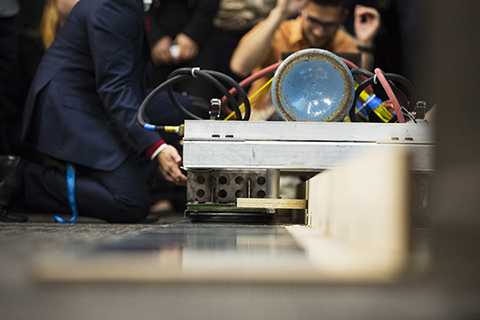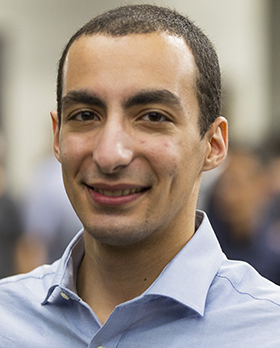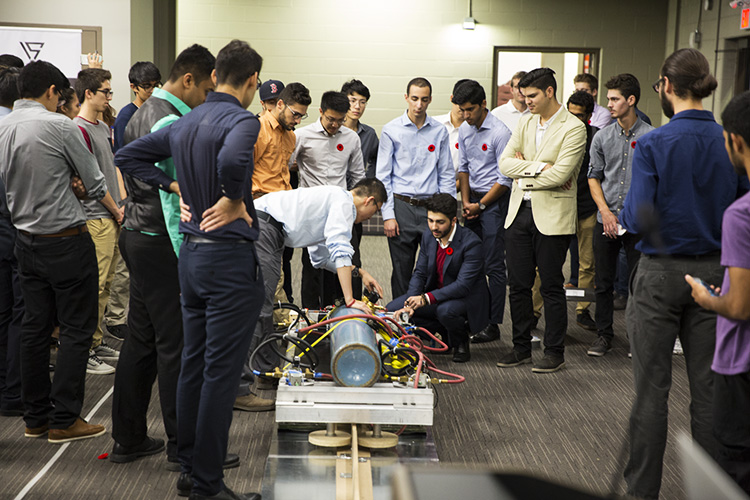Heralded by the sound of compressed air releasing, followed by a whir, and then a staccato drumming of onboard motors, let the record show that at precisely 1930 hours on Nov. 1, 2016, a group of ambitious University of Waterloo students made history.
That was when their six-foot-long metal frame bearing hoses, controllers, an air bottle and sundry other technological wizardry, levitated – yes, levitated – from terra firma and glided on a cushion of air along a short test track set up at University of Waterloo’s Federation Hall.
Accompanied by applause and expressions of astonishment from the 100 or so attendees, so unfolded the first public demonstration of what is believed to be the world’s only functional pneumatic hyperloop air levitation system.
The Waterloop, as it’s known, is the brainchild of about 120 UW students from across a multitude of disciplines who have set out to conquer an international challenge issued by SpaceX entrepreneur Elon Musk – design and build a functioning prototype pod intended to carry people at high speed inside a vacuum tube, and in so doing revolutionize the transportation business as we now know it.
The Waterloo team is one of 22 remaining entrants from an initial competition involving 1,200 teams. In January, 2017 the Waterloop team will travel to Hawthorne, Calif., where they will pit their craft against the remaining others on a 1.6-kilometre test track at the SpaceX facility.

Members of the University of Waterloo Hyperloop team demonstrate their
‘Waterloop’ technology. (Communitech photo: Phil Froklage)
Proving the levitation system was key. The Waterloo team used air rather than magnets as a lift mechanism to reduce friction, reduce cost and simplify design elements.
“The most exciting thing is we’ve got it levitating,” said 21-year-old team captain Yazan Obeidi. “The scary thing is we’re now building (the prototype) with very little time (remaining).
“We basically have to build it, test over three of four weeks and then break for the holidays, come back and test for another week, and then we’re off to California.
“But the passion of the team, the contributions of the sponsors, it’s going to happen. We’re very determined.”
The Waterloo team is the only remaining Canadian entrant.
The excitement around the project, evident in the room Tuesday, is manifested in a Kickstarter campaign launched recently with goal of raising Cdn$20,000 to spend on prototype construction. The group reached 50 per cent of their goal within 48 hours and have now raised more than $27,000.

Yazan Obeidi, captain of the University of
Waterloo’s Hyperloop challenge team.
(Communitech photo: Phil Froklage)
The hyperloop concept was first broached by Musk – the driving force behind the Tesla automobile – in 2013. The vacuum within the tube reduces air friction, allowing speeds in excess of 1,200 km/h. If the concept were to prove successful, travel by automobiles, trains and even aircraft would be rendered moot.
The moon-shot quality of the project was expressed Tuesday by SHAD President and CEO Tim Jackson, the event’s keynote speaker.
“We’re not talking about building an app, or doing something simple,” said Jackson, a former vice-president at the University of Waterloo. “We’re talking about something transformational.”
With Tuesday’s event now behind them, the focus will now shift to the team’s test track facility at Kitchener innovation hub Lot 41.
Hurdles remain, not least among them juggling exams, classes and co-op placements and keeping to an extraordinarily tight timeline.
“It is a very challenging task,” said faculty advisor Serhiy Yarusevych, an associate professor of engineering at Unversity of Waterloo. “This would be an extremely challenging task for a professional engineering firm. It’s an extraordinary challenge for a group of engineering students.
“But it’s also a tremendous opportunity for them. They’re very motivated.”


